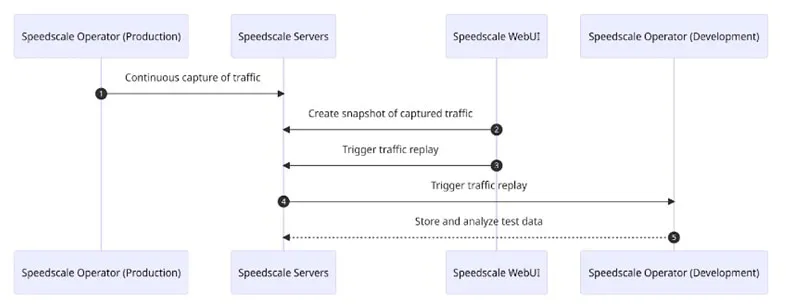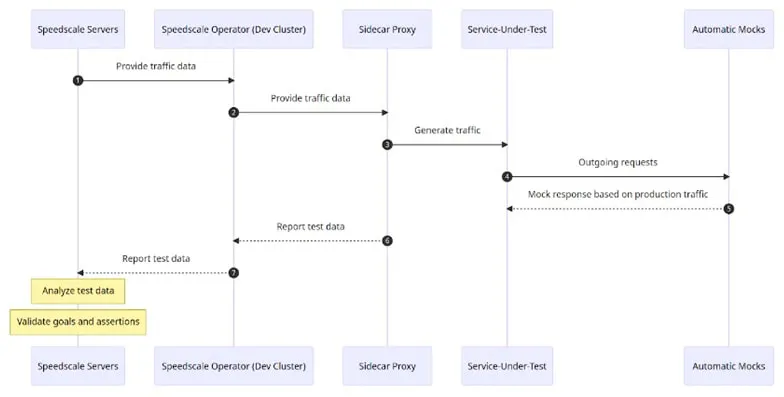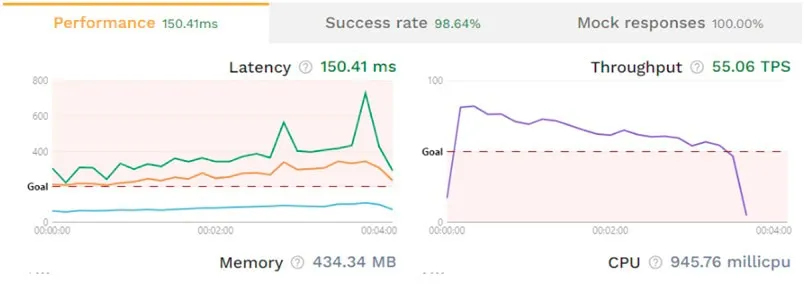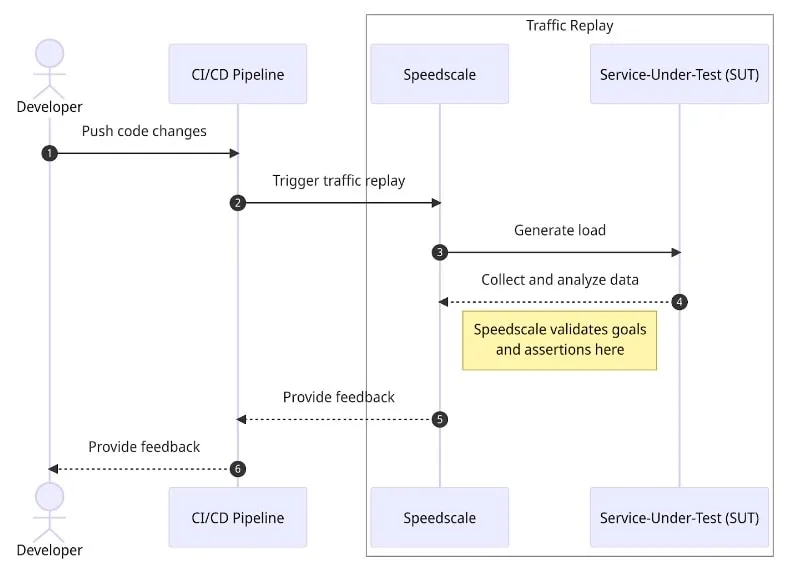Regression testing is not a new concept. However, historically, it has been limited to functional testing due to the setup, configuration, and maintenance required to simulate a production environment accurately. Many teams have found the cost outweighs the benefits, but with the advent of production traffic replication (PTR), it’s become a viable option to regression test performance, especially for those running applications in Kubernetes.
What is software “performance”?
Software performance refers to how effectively a software application responds to specific demands. Performance encompasses several key aspects, including load time, responsiveness, and the efficiency with which it processes data. Performance metrics are vital for gauging an application’s health and user satisfaction.
Functional vs Non-Functional
Performance is considered non-functional. Compared to functional aspects which are the “what” of your application (business specific value props), non-functional aspects explain the “how” of your application (qualities like security, availability, etc.). For example, Stripe offering a monthly billing product is functional, while the ensuring those transactions are secure is non-functional. Although non-functional requirements might feel secondhand to functional, they are just as important to the success of your product.
Metrics for Performance
Metrics for performance can include data points like resource utilization (CPU, memory, etc.), average latencies, response times, and so forth. These raw data points can be analyzed on averages, or percentiles for outliers such as 95% percentile. More advanced statistics such as mean absolute error, mean absolute percentage error, and root mean squared error among others can be used to build a better data set for performance insights. High-performing software not only meets the functional requirements but also delivers a smooth, responsive user experience. Performance testing ensures that an application can handle expected loads and identifies potential performance issues before they impact users.
What is software “regression”?
Software regression occurs when new changes introduce errors in existing parts of a software application. Regressions are typically seen more once software products become increasingly more complex.
What causes software regression?
Software regressions come from errors while programming around existing code. This could be a bug fix that resolves the original issue but introduces another issue. Regressions could also result from poor configuration file changes which cause unexpected behavior down the line. Even if these original changes lower your application’s total number of issues, it’s not impossible for these changes to introduce regressions worth fixing.
Impact of software regressions
A regression can range from minor bugs affecting non-critical features to significant performance regressions that degrade the user experience or system stability. Identifying and addressing regressions quickly is crucial to maintain software quality and performance. Regression testing plays a pivotal role in this process, ensuring that updates or additions to the codebase do not adversely affect the application’s existing functionality or performance metrics.
Testing Performance and Regression
In isolation, both performance and regression tests serve vital roles to software delivery.
Performance Testing
Performance testing is a critical aspect of software quality assurance that focuses on determining how a system performs in terms of responsiveness and stability under a particular workload. It is not just about finding bugs but also about identifying performance regressions and bottlenecks that could lead to performance issues in the live environment. Key performance metrics such as load time, throughput, and the use of resources are measured against defined criteria. Performance tests simulate varying loads on the system to predict how new or updated features will perform under different conditions. This testing helps ensure that the application meets its performance goals, provides a good user experience, and remains stable under peak traffic conditions. Performance testing is essential for identifying potential performance problems before they become actual performance issues in a production environment.
Regression Testing
Regression testing is a type of software testing that ensures newly developed features or code changes do not negatively impact the existing functionality of an application. It involves re-running a comprehensive test suite of existing tests on the modified software to detect any regressions. Regression testing is not just about ensuring that existing features continue to work as expected after changes or optimizations are deployed, but also when new features or optimizations are added to the same codebase. Regression testing can be automated to handle the vast array of test cases efficiently, significantly reducing the time and resources required to perform thorough testing. The goal is to identify and rectify any regressions or performance issues introduced by recent code changes, maintaining the software’s integrity and model performance.
Better together: Performance Regression Testing
Using both methodologies together, performance regression testing can create new insights into the capabilities of your application.
Importance of performance regression testing
While it’s likely you’re familiar with the concept, it’s important to understand its relevance to non-functional aspects of your application. Regression tests allow you to detect performance regressions early in the development cycle, before changes are deployed to production, saving significant time and resources that would otherwise be spent on troubleshooting and fixing issues in production. This helps maintain a high-quality user experience, which is particularly important for applications where performance heavily impacts user satisfaction, such as streaming services or e-commerce platforms.
Challenges with performance regression testing
But, as mentioned above, this concept has rarely been transferred to non-functional tests, like those validating response times and throughput. This is in large part due to the complexity of setting up these tests, as they require you to accurately simulate your production environment. Not only the dependencies and infrastructure but the real-life usage as well. As production traffic replication captures and stores sanitized traffic from your production environment—specifically the services you’ve configured to record—you can be confident that new features or changes will not negatively impact performance. As more and more regression tests are implemented, this can speed up the deployment process and reduce the risks associated with introducing new features. Using Production Traffic Replication for Performance Regression Testing  Consider a hypothetical scenario involving a popular video streaming service, “StreamFast”, which recently implemented a significant latency optimization on a specific endpoint, /instant. This endpoint is responsible for providing instant video playback when a user clicks on a video thumbnail. The optimization has significantly improved the user experience by reducing the video load time. StreamFast is deployed in a Kubernetes environment, and the development team has been using the Speedscale operator for months to continuously capture production traffic. This has been instrumental in identifying performance bottlenecks and understanding the behavior of their service under real-world conditions. Implementing production traffic replication with Speedscale is fairly straightforward, and the steps can be found in the complete traffic replay tutorial. The real challenge lies in knowing how to effectively utilize it.
Consider a hypothetical scenario involving a popular video streaming service, “StreamFast”, which recently implemented a significant latency optimization on a specific endpoint, /instant. This endpoint is responsible for providing instant video playback when a user clicks on a video thumbnail. The optimization has significantly improved the user experience by reducing the video load time. StreamFast is deployed in a Kubernetes environment, and the development team has been using the Speedscale operator for months to continuously capture production traffic. This has been instrumental in identifying performance bottlenecks and understanding the behavior of their service under real-world conditions. Implementing production traffic replication with Speedscale is fairly straightforward, and the steps can be found in the complete traffic replay tutorial. The real challenge lies in knowing how to effectively utilize it.
The Complete Traffic Replay Tutorial
Executing Performance Testing
 The StreamFast team recently made a breakthrough in reducing the latency of the /instant endpoint. Now, they want to ensure that this optimization is not negatively impacted by any future features or enhancements. With the Speedscale operator continuously capturing their traffic, the team can easily create a snapshot of the current traffic from the Speedscale WebUI.
The StreamFast team recently made a breakthrough in reducing the latency of the /instant endpoint. Now, they want to ensure that this optimization is not negatively impacted by any future features or enhancements. With the Speedscale operator continuously capturing their traffic, the team can easily create a snapshot of the current traffic from the Speedscale WebUI.
Insights from production traffic
This snapshot includes data related to the traffic, including headers, request body, and other information relevant to the service with the /instant endpoint. This data is then used to replicate the exact conditions under which the service operates in production, even creating automatic mocks to handle third-party dependencies.
Testing with traffic replication
The team then replays this snapshot in a non-production environment that mirrors their production setup. The combination of accurate mocks and real-life traffic allows them to test how any code changes might impact the performance of the /instant endpoint under realistic conditions—without ever impacting the production environment or the customers using it.
Setting Performance Goals
 True regression testing comes into play when setting performance goals. By setting goals for latency and throughput, the development team can verify whether the service still performs as expected. The team sets a goal to verify that the /instant endpoint has no 95th percentile latency over 200ms, and that transactions-per-second doesn’t go below 50 on average. This goal serves as a performance benchmark that all future changes must meet or exceed. Although a goal can be used to validate just a single endpoint, it’s important that all traffic is being replayed, as an uneven distribution can lead to misleading performance metrics. Once the traffic replay has been executed, Speedscale saves and analyzes the data, which can then be viewed in a report.
True regression testing comes into play when setting performance goals. By setting goals for latency and throughput, the development team can verify whether the service still performs as expected. The team sets a goal to verify that the /instant endpoint has no 95th percentile latency over 200ms, and that transactions-per-second doesn’t go below 50 on average. This goal serves as a performance benchmark that all future changes must meet or exceed. Although a goal can be used to validate just a single endpoint, it’s important that all traffic is being replayed, as an uneven distribution can lead to misleading performance metrics. Once the traffic replay has been executed, Speedscale saves and analyzes the data, which can then be viewed in a report. 
Continuous Regression Testing
 Once the team has performed this regression test, they implement it as a continuous process. Continuous performance testing is a powerful way of validating the non-functional aspects of your application, without needing real users. Moreover, moving away from script-based testing makes it a viable option for developers, as tests from traffic can be generated immediately, as opposed to manually writing scripts, ultimately requiring very few engineering hours after setup. This continuous regression testing is integrated into the team’s CI/CD pipeline, ensuring that performance is always considered as part of the development process. This approach helps maintain high performance and prevents performance regressions from being introduced into production—without creating additional cognitive load during the development process.
Once the team has performed this regression test, they implement it as a continuous process. Continuous performance testing is a powerful way of validating the non-functional aspects of your application, without needing real users. Moreover, moving away from script-based testing makes it a viable option for developers, as tests from traffic can be generated immediately, as opposed to manually writing scripts, ultimately requiring very few engineering hours after setup. This continuous regression testing is integrated into the team’s CI/CD pipeline, ensuring that performance is always considered as part of the development process. This approach helps maintain high performance and prevents performance regressions from being introduced into production—without creating additional cognitive load during the development process.
A Developer’s Guide to Continuous Performance Testing
Extending Regression Testing
While regression testing is vital for verifying the functional aspects of an application, PTR can also be used to regression test performance of an application. For example—as detailed above—by setting up continuous load testing. In conclusion, regression testing is a critical part of software development. With the advent of PTR, it has become easier and more efficient to conduct regression testing for performance, especially due to traffic-based mocks. By extending regression testing to include performance aspects, you can ensure that your application continues to deliver a high-quality user experience.